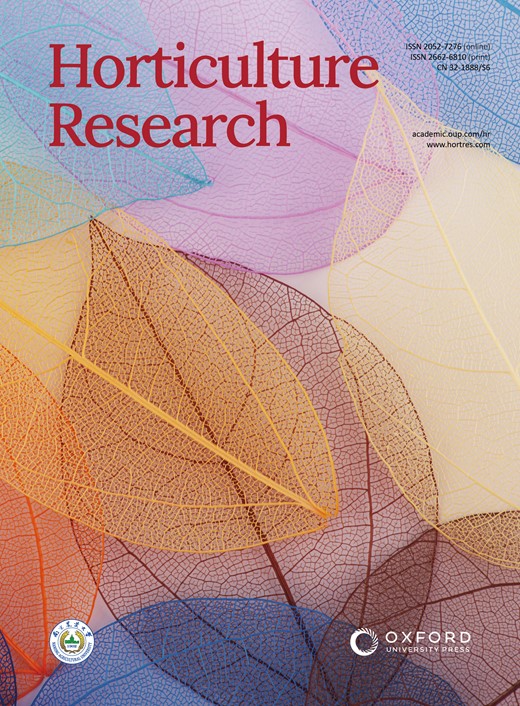转录因子 LvBBX24 和 LvbZIP44 协调百合花瓣中花青素的积累以应对光照
IF 8.7
1区 农林科学
Q1 Agricultural and Biological Sciences
引用次数: 0
摘要
百合(百合属)是一种兼具观赏和食用功能的园艺作物,其颜色主要来自花青素。然而,有关百合花内花青素积累的研究还很有限。在这项研究中,我们克隆了百合中的一个光诱导转录因子,命名为 LvBBX24。通过遗传和生化分析,我们确定 LvBBX24 可以上调 LvMYB5 的转录,促进花青素的合成。此外,我们还发现黑暗会促进 LvBBX24 蛋白的降解。通过筛选酵母文库,我们发现 LvbZIP44 是其相互作用伙伴。遗传测试证实,LvbZIP44 也在促进百合花青素合成方面发挥作用。这表明 LvBBX24 和 LvbZIP44 之间可能存在协同调控效应。我们的研究表明,LvBBX24 和 LvbZIP44 合作调控百合花瓣中花青素的积累。这些发现提供了令人信服的证据,支持 LvBBX24 和 LvbZIP44 可能在 LvMYB5 启动子区域周围形成环状螺旋来调控花青素生物合成的观点。本文章由计算机程序翻译,如有差异,请以英文原文为准。
Transcription Factors LvBBX24 and LvbZIP44 Coordinated Anthocyanin Accumulation in Response to Light in Lily Petals
Lily (Lilium spp.), a horticultural crop serving both ornamental and edible functions, derives its coloration primarily from anthocyanins. However, limited studies have been conducted on the accumulation of anthocyanins within lilies. In this study, we cloned a light-induced transcription factor named as LvBBX24 in lilies. Through genetic and biochemical analysis, we determined that LvBBX24 could upregulate the transcription of LvMYB5 and facilitate anthocyanin synthesis. Moreover, we identified that darkness promoted the degradation of LvBBX24 protein. Through screening a yeast library, we identified LvbZIP44 acts as its interacting partner. Genetic testing confirmed that LvbZIP44 also plays a role in promoting lily anthocyanin synthesis. This indicates a potential synergistic regulatory effect between LvBBX24 and LvbZIP44. Our study indicates that LvBBX24 and LvbZIP44 cooperate to regulate anthocyanin accumulation in lily petals. These findings provide compelling evidence supporting the idea that LvBBX24 and LvbZIP44 may form a looped helix surrounding the LvMYB5 promoter region to regulate anthocyanin biosynthesis.
求助全文
通过发布文献求助,成功后即可免费获取论文全文。
去求助
来源期刊

Horticulture Research
Biochemistry, Genetics and Molecular Biology-Biochemistry
CiteScore
11.20
自引率
6.90%
发文量
367
审稿时长
20 weeks
期刊介绍:
Horticulture Research, an open access journal affiliated with Nanjing Agricultural University, has achieved the prestigious ranking of number one in the Horticulture category of the Journal Citation Reports ™ from Clarivate, 2022. As a leading publication in the field, the journal is dedicated to disseminating original research articles, comprehensive reviews, insightful perspectives, thought-provoking comments, and valuable correspondence articles and letters to the editor. Its scope encompasses all vital aspects of horticultural plants and disciplines, such as biotechnology, breeding, cellular and molecular biology, evolution, genetics, inter-species interactions, physiology, and the origination and domestication of crops.
 求助内容:
求助内容: 应助结果提醒方式:
应助结果提醒方式:


